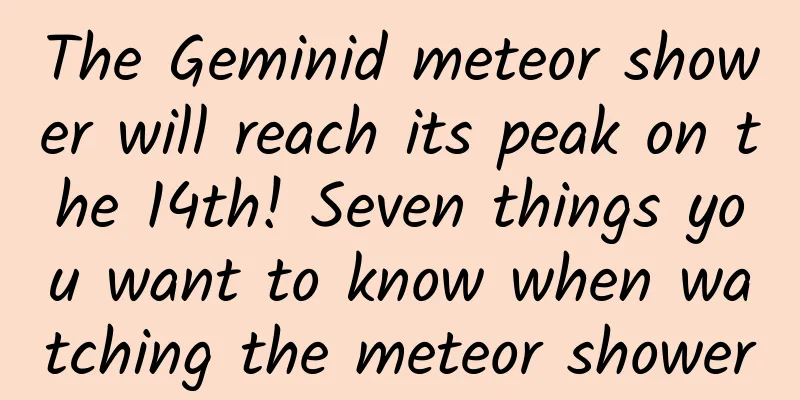The Geminid meteor shower will reach its peak on the 14th! Seven things you want to know when watching the meteor shower

|
Every December, what astronomy enthusiasts look forward to most is the annual Geminid meteor shower! This is also one of the largest and most spectacular meteor showers of the year. The Geminid meteor shower, one of the three major meteor showers in the northern hemisphere, will reach its peak on December 14. Friends who like meteor showers can observe it in the second half of the night. This reporter learned from the Beijing Planetarium that this year's Geminid meteor shower will reach its peak meteor number around 15:00 Beijing time on December 14, with an estimated maximum of 150 zenithal meteors per hour. For observers in my country, the best time to observe this meteor shower is after dark on the 14th. Observation in the first half of the night may be affected by moonlight, but in the second half of the night, after the moon sets and before dawn, the impact of moonlight is significantly weakened, making it the best time to observe. The Geminid meteor shower was photographed by Beijing astronomy enthusiast An Jiu in Qinghai on December 13, 2018. (Photo provided by the author) Most meteor showers are born from periodic comets, but the parent of the Geminids is 3200 Phaethon, an Apollo-type asteroid. The Geminids are also the second known meteor shower that is not "born" from a comet. Yuan Fengfang, an astronomy enthusiast from Guangdong Province, photographed the Geminid meteor shower at the Xinglong Observatory of the National Astronomical Observatory of the Chinese Academy of Sciences on December 14, 2018. (Photo courtesy of Starlink CSVA) Xiu Lipeng, director of Tianjin Astronomical Society and astronomy popularization expert, said that just like the New Year's blockbuster, the Geminid meteor shower usually appears at the end of the year, and the "release period" can last from December 4 to 17. This meteor shower is known for its large and stable flow, and is known as one of the three major meteor showers in the northern hemisphere along with the Quadrantid meteor shower and the Perseid meteor shower. A notable feature of the Geminid meteor shower is that the meteors are slow, colorful, and there are many fireballs, which is suitable for both visual observation and astrophotography beginners. The Geminid meteor shower was photographed by Tianjin astronomy enthusiast Yang Jing in Jizhou, Tianjin on December 13, 2020. (Photo provided by the author) Astronomical forecasts show that this year's Geminid meteor shower will reach its peak around 15:00 on December 14, with a ZHR (the number of meteors that can be seen per hour under ideal observation conditions when the radiant point is directly overhead) of 150 at its peak. Geminid meteor shower recommended index chart. (Author: Astronomy science comic blogger EasyNight) "Last year, the 'falling petals' Geminid meteor shower left a deep impression on people, but this year's Geminid meteor shower will be disturbed by moonlight, and its excitement will be reduced a little. The 14th is the 11th day of the 11th lunar month, and the moon is in a waxing gibbous phase. The bright moonlight will interfere with observation, but fortunately the moon will set in the second half of the night, and the radiant point of the Geminid meteor shower will rise higher at this time. Friends who like meteor showers can observe them in the few hours after the moon sets in the second half of the night, but they must pay attention to keep warm." Xiu Lipeng said. Wei Wenjun, an astronomy enthusiast from Yunnan Province, photographed the Geminid meteor shower at Lugu Lake in Yunnan on December 14, 2020. (Photo courtesy of Starlink CSVA) He Hongcheng, an astronomy enthusiast from Anhui Province, photographed the Geminid meteor shower at Lugu Lake in Yunnan on December 14, 2020. (Photo courtesy of Starlink CSVA) The Geminid meteor shower was photographed by Sichuan astronomy enthusiast Jiang Tao in Yuzixi, Ganzi Prefecture, Sichuan on December 14, 2020. (Photo courtesy of Starlink CSVA) The Geminid meteor shower was photographed by Beijing astronomy enthusiast Jiang Chenming in Duolun County, Inner Mongolia on December 14, 2020. (Photo courtesy of Starlink CSVA) How can we observe as many meteors as possible? "It is not recommended to observe in the city. You can choose a place with high altitude, little light pollution and a wide view facing the northeast in the suburbs or countryside, and then wait patiently until the moon sets and observe visually. It should be noted that the Geminid meteor shower has a large flow in all directions, so you don't have to stare at the radiant point of the Geminid meteor shower when observing. Friends who like photography want to shoot gorgeous 'meteor shower blockbusters', it is best to choose a wide-angle, large aperture lens, and use high ISO and maximum aperture when shooting. Based on stability and sustainability considerations, a tripod, spare batteries and shutter release cable are also essential." Xiu Lipeng reminded. Seven things you want to know when we watch meteor showers 01 What is the relationship between meteors, meteor showers, and meteor storms? Our solar system is a lively big family. In addition to the sun, the eight planets and their satellites, and dwarf planets, there are also a vast number of small things - asteroids and comets, even smaller micrometeoroids, and micrometer-sized cosmic dust. The Earth, asteroids, comets, micrometeoroids, and cosmic dust all orbit the Sun, and their orbits intersect. If they meet at the same time and in the same place, it will cause a "traffic accident" in the solar system. Comets are dirty snowballs made of water ice and rock, and they usually disintegrate in the atmosphere. Asteroids are mainly made of solid rock. Asteroids with a diameter of more than 100 meters usually pass directly through the atmosphere and reach the surface of the earth, creating impact craters, accompanied by strong shock waves, thermal radiation, earthquakes, tsunamis and other disasters. Small asteroids will disintegrate and explode in the atmosphere, forming bright fireballs accompanied by rumbling explosions. Basic Concepts/ American Meteor Society Meteors are micro-meteoroids of millimeter to centimeter size that enter the atmosphere at high speed, squeezing and rubbing the atmosphere, causing the surface temperature of the asteroid to rise, and ablation causes the luminous phenomenon. Most meteors disintegrate at an altitude of 80-120 kilometers and are not accompanied by sound. Meteor Shower / breezyscroll.com Meteor showers are groups of meteors that encounter the earth. People see a large number of meteors bursting out and falling from a certain point in the night sky. This point is also called the radiant point of the meteor shower. Meteor showers are usually named after the constellations in the sky where the radiant point of the meteor shower is located. For example, the Leonid meteor shower and the Perseid meteor shower. When a meteor shower exceeds a certain intensity (for example, the number of meteors per hour at the zenith exceeds 1,000), it can be called a meteor storm. 02 Where do meteor showers come from? The parent bodies of meteor showers are generally comets, but some meteor showers may also have asteroids as their parent bodies. Comets are dirty snowballs made of water ice and grit. When approaching the sun, sublimated water ice will carry grit away from the comet's surface. With the disturbance of gravity and light pressure, the grit gradually spreads in the comet's orbit, forming an elliptical belt full of grit. When the earth passes through this grit belt, a meteor shower will occur. Earth passes through comet orbit / skyandtelescope.org The parent body of the Geminid meteor shower is the asteroid 3200 Phaethon. Why an asteroid becomes the parent body of a meteor shower has not yet been fully explained. One explanation is that the asteroid 3200 Phaethon may have experienced a serious "traffic accident" in the solar system a long time ago, resulting in a large amount of splashes scattered in the orbit. 3200 Phaethon Asteroid Orbit / earthsky.org In addition, 3200 Phaethon is one of the asteroids closest to the Sun at perihelion, with the closest distance being only about 29 million kilometers, twice the distance between Mercury and the Sun. Evaporated by sunlight, 3200 Phaethon will have a small dust tail when it approaches the Sun. 03 What are the famous meteor showers in the world? The Quadrantids, Perseids and Geminids are known as the three major meteor showers in the Northern Hemisphere, with more than 100 meteors per hour at the zenith. Meteor shower time and parent body/NASA The Leonid meteor shower is also known as the "king of meteor showers". Its intensity shows obvious periodic characteristics. The intensity of meteor showers is usually low, about 10 to 15 meteors per hour, but on average every 33 to 34 years, the Leonid meteor shower will reach a peak, the number of meteors can exceed thousands per hour, forming a meteor storm. In 1883, the Leonid meteor shower experienced a super-strong outburst, setting a record for an intensity of 100,000 meteors per hour, earning the Leonid meteor shower the reputation of "the king of meteor showers". The Leonid meteor shower was a super outburst in 1883 / Adolf Vollmy The last Leonid meteor shower erupted in 2001. According to statistics, nearly 9,000 meteors streaked across the sky every hour at its peak. The next Leonid meteor shower is expected to erupt in 2034. 04 What colors are shooting stars? If you are careful, you may find that meteors have different colors. What is the difference between meteors of different colors? In fact, the color of a meteor is a reflection of the chemical composition and reaction temperature of the meteor body. Meteors of different compositions will show different colors when passing through the atmosphere. Meteor Color and Composition/ALMA The main components of meteoroids are calcium, magnesium, sodium, iron, silicon and other elements. Different elements emit different wavelengths of light when ablated. For example, calcium atoms emit purple light; magnesium atoms emit blue-green light; sodium atoms emit orange-yellow light; iron atoms emit yellow light; silicon atoms emit red light. The numerous nitrogen and oxygen atoms in the air emit red light. The color of a meteor is also related to the ablation temperature. Many meteors tend to have a green tail in the initial stage, which corresponds to the emission spectrum of oxygen atoms in the upper atmosphere. As the temperature rises, the meteor body is more ablated and gradually shows the emission spectrum characteristics of the meteor body material. The ablation temperatures of different material components are different, which further increases the complexity of the meteor spectrum. 05 Do meteor showers endanger astronauts? The chance of a space station being hit by a meteor is very low, but it does not mean there is no possibility. Olympus 1 was a European Space Agency communications satellite in the 1980s. At the time, it was the largest civilian communications satellite ever built. During the peak of the Perseid meteor shower on August 11-12, 1993, the satellite lost control and began to spin. It is speculated that it was hit and damaged by fragments of Comet Swift-Tuttle (109P / Swift-Tuttle). Eventually, Olympus was sent to the "satellite junkyard" - the GEO discard orbit. Olympus 1 communications satellite/ESA When choosing a launch window, we will try to avoid the peak of the meteor shower. The period from 1997 to 2002 coincided with the return period of the Leonid meteor shower, which occurs every 33 years. The parent comet Tempel-Tuttle, which produces this famous meteor shower, returned to perihelion. As it was very close to the Earth's orbit, the meteoroid particles gathered in front and behind the comet were ejected toward the Earth at high speed, producing a meteor storm far exceeding the usual. Spacecraft launched or operated during this period must consider the possible impact of meteor storms. Experts from the Space Environment Forecast Center of the Chinese Academy of Sciences predicted that the Shenzhou-1 spacecraft was originally scheduled to be launched at 7:00 Beijing time on November 18, 1998, which coincided with the strongest period of the Leonid meteor storm, and the meteor storm ended at 7:00 on November 20, two days later. "Shenzhou-1" launch/ Internet At that time, Gu Yidong, the chief designer of the spacecraft application system, asked what the probability of encountering a meteor shower on the 18th was. Gong Jiancun, director of the Space Environment Forecast Center, said that if the launch was launched on the 18th, the risk would be 100%. If it was postponed for 24 hours, the risk would be 6%. If it was postponed for 48 hours, the risk would be almost zero. Based on this, they suggested that the launch of the spacecraft be postponed for 2 days, which ensured the safe operation of Shenzhou-1. 06 Do meteor showers always occur at night? No, there are meteor showers during the day as well. It's just that the light during the day is too strong, so people usually can't see meteor showers that occur during the day. Modern scientists can study meteor showers that occur during the day with the help of facilities such as meteor radar. The Sextantids meteor shower occurs during the day and reaches its peak around September 27th each year. Since it occurs during the day, the radiant point of the Sextantids meteor shower is very close to the sun, making it one of the most difficult meteor showers to observe. You need to wear goggles to observe the Sextantids meteor shower, otherwise your eyes may be damaged by the glare of the sun. In addition, you can also watch the Sextantids meteor shower before sunrise, and the best observation time is 4:30 in the morning. NASA All-Sky Fireball Network captures daytime meteors/NASA 07 Have ancient people ever seen meteor showers? Yes, the ancients not only saw meteor showers, but also made detailed records. China is the first country to record meteor showers. The Bamboo Annals recorded that "in the fifteenth year of Emperor Xia, stars fell like rain in the night." The Zuo Zhuan recorded that "on the night of Xinmao in the fourth month of summer, the stars disappeared, and stars fell like rain in the night." The meteor shower recorded in the book occurred in April of the seventh year of Duke Zhuang of Lu (687 BC), which is the earliest record of the Lyrid meteor shower in the world. "Zuo Zhuan" records the Lyrid meteor shower/Internet According to statistics from experts, there are as many as 180 records of meteor showers in ancient my country, including about 9 records of the Lyrid meteor shower, about 12 records of the Perseid meteor shower, and 7 records of the Leonid meteor shower. Ancient Chinese records of the moving scenes of meteor showers are also very interesting. During the Southern and Northern Dynasties, Emperor Xiaowu of Liu Song wrote, "In March of the fifth year of Daming, the moon covered Xuanyuan. There were tens of millions of meteors, some long, some short, some big, some small, all traveling westward until dawn." Comprehensive sources: Xinhua News Agency, Xinhuanet, CCTV News, People's Daily, China National Astronomy Bureau, etc. |
<<: How much of the oily fish known as "Splatoon" should you eat every day to be safe?
Recommend
How much does it cost to be an agent of Wuxi Home Improvement Mini Program? What is the price of being an agent for Wuxi home improvement mini program?
Why should you be an agent for WeChat Mini Progra...
Why are plant extracts commonly found in skin care products not written as chemical names?
Skin care products have become a necessity in our...
iQIYI Verb Wireless Earphones: 25 days of ultra-long standby, lightweight and luxurious wireless sound experience
What is the most important thing for young people...
How to create a Kuaishou account from scratch? Here’s a how-to guide!
How to create a Kuaishou account from scratch? Af...
How to write a short video title? How to write an excellent short video title?
Many people say that making short videos is too d...
Insect fighting, cock fighting, bull fighting... do you know about tea fighting?
Lv Weitao, Curator at the National Museum of Chin...
An egg falling from a high altitude can kill a person, so why can a cat jump from the 32nd floor and survive?
Editor’s Note: Please do not conduct any tests or...
Why are vaccines never given in the buttocks? Why are they only given in the arm, which is super painful?
inject That may be everyone's childhood shado...
Foreign trade tips | SNS marketing methods
Although social media tools vary and marketing me...
What should I do if I want to quickly sell Didi’s friend links?
Click Sell Friendly Links → My Website page, clic...
Tencent Social Advertising Zhang Minyi: Redefining "Precision" in Social Scenarios
On November 3rd three years ago, the first inform...
Is the Apple Watch SE worth buying? You have to ask the Series 5 first
With the hot sales of iPhone XR in 2018, Apple ta...
Gentleman's emotions, 2022 social pursuit of women's general rules, love teaching video_Baidu cloud disk tutorial video
Gentleman's Emotions, 2022 Social Chasing Gir...
Popular Science | Learn about the important vitamin for the human body - Vitamin K
Vitamins are an essential topic when it comes to ...









